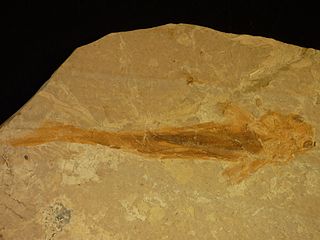Chanopsis is an extinct genus of prehistoric freshwater bonytongue relative that lived from the late Aptian to the Albian stage of the Early Cretaceous epoch. It contains a single species, C. lombardi from the Democratic Republic of the Congo.

Eubiodectes is an extinct genus of prehistoric bony fish that lived during the Cenomanian.
Chongichthys is an extinct genus of prehistoric marine ray-finned fish that lived during the Oxfordian stage of the Late Jurassic epoch. It contains one species, C. dentatus from the Quebrada El Profeta of Chile. It is named after Chilean geologist Guillermo Chong.
Luisiella is an extinct genus of prehistoric bony fish that lived during the Kimmeridgian stage of the Late Jurassic epoch. Fossils of the genus have been found in either the Cañadón Calcáreo Formation or Cañadón Asfalto Formation in Chubut Province, Argentina.
Africentrum is an extinct genus of prehistoric soldierfish that lived during the Upper Miocene subepoch of what is now Malta. It contains a single species, A. melitense. It has been either recovered as the sister genus to Myripristis or in a polytomy with all the other genera in the subfamily.
Agecephalichthys is an extinct genus of prehistoric freshwater "palaeonisciform" ray-finned fish that lived during the Anisian age. It contains a single species, A. granulatus from the Hawkesbury Sandstone in what is now New South Wales, Australia.
Cosmoptychius is an extinct genus of freshwater and estuarine ray-finned fish that lived during the Mississippian epoch. It contains a single species, C. striatus from the Visean of Scotland. It has a wide stratigraphic range in the Wardie Shale, with many specimens known.
Chrotichthys is an extinct genus of prehistoric freshwater ray-finned fish that lived in the Anisian stage of the Middle Triassic epoch. It contains a single species, C. gregarius, known from the Terrigal Formation of New South Wales, Australia.
Euporosteus is an extinct genus of prehistoric sarcopterygian or lobe-finned fish.
Iowadipterus is an extinct genus of prehistoric sarcopterygian or lobe-finned fish.

Paraceratodus is an extinct genus of prehistoric lungfish. Only one species, P. germaini, is known from the latest Permian or earliest Triassic period of Madagascar. Phylogenetic evidence supports it being the most basal member of the suborder Ceratodontoidei, which contains modern lungfish, and as with the rest of the order it likely diverged during the late Carboniferous.

Anaethalion is an extinct genus of prehistoric marine and freshwater ray-finned fish related to modern tarpons and ladyfish. It is known from the Late Jurassic to the Early Cretaceous of Europe and northeasterrn Asia, roughly encompassing the Tethys Ocean.

Bobasatrania is an extinct genus of prehistoric marine ray-finned fish that survived the Permian-Triassic extinction event. Fossils of Bobasatrania were found in beds of Changhsingian to Ladinian age. It was most speciose during the Early Triassic.

Cretatriacanthus is an extinct genus of prehistoric marine ray-finned fish from the Late Cretaceous. It contains a single species, C. guidottii from the late Campanian or early Maastrichtian of Nardò, Italy. It is generally placed as a basal tetraodontiform, although more recent studies have disputed this, finding it to instead represent an early basal percomorph.
Sundayichthys is an extinct genus of prehistoric bony fish that lived during the Carboniferous period in what is now South Africa. Fossils were recovered from the Upper Witteberg Series.
Egertonia is an extinct genus of prehistoric bony fish. The earliest occurrences of the genus in the fossil record are from the Late Cretaceous of Madagascar and India.
Korutichthys is an extinct genus of prehistoric marine bony fish that lived during the Lopingian epoch in what is now Krasnoyarsk Krai, Russia. It was first referred to the family Amblypteridae, a view that was later questioned.

Peipiaosteus is an extinct genus of prehistoric chondrostean ray-finned fish. Its fossils are found in the Early Cretaceous Jiufotang Formation, Pani Lake, Liaoning Province, China.
Joffrichthys is a genus of prehistoric bony fish. This North American genus includes three species, J. symmetropterus, J. tanyourus and J. triangulpterus. The last species is known from the Paleocene of the Sentinel Butte Formation of North Dakota.

Morrolepis is an extinct genus of prehistoric coccolepidid "palaeoniscoid" ray-finned fish that lived during the Late Jurassic and earliest Cretaceous epochs in Europe, Asia and North America.






